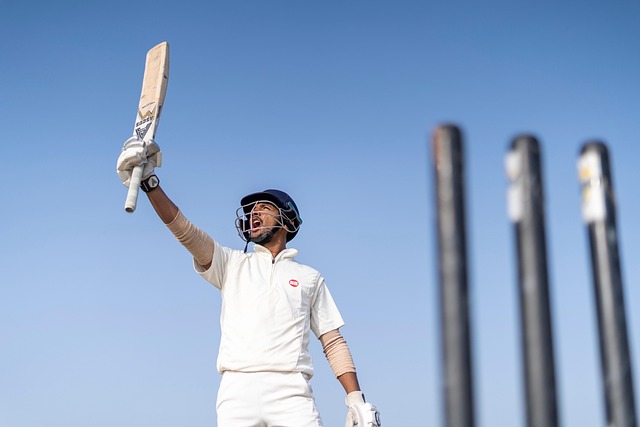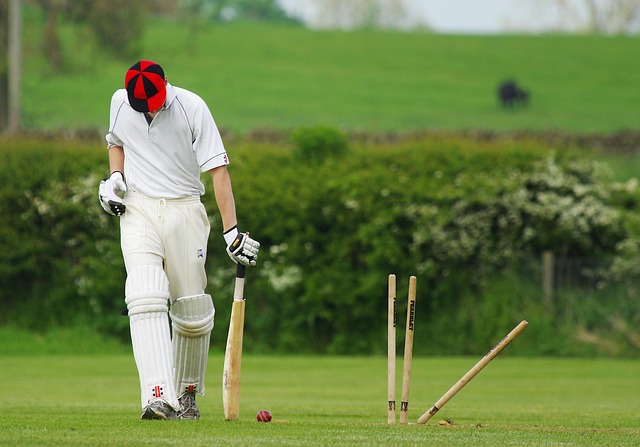
Cricket wicket repair involves meticulous inspection, using high-quality materials, and precise setting to maintain fairness, safety, and historical standards. Digital tools aid accuracy in measurements crucial for player performance and strategic decisions. Temporary halts ensure replacement aligns with global cricket guidelines, enhancing the overall playing experience globally.
In the fast-paced world of cricket, a broken wicket can pause play and disrupt the flow of the game. Understanding how to safely and correctly replace it is crucial. This guide delves into the essential steps, from assessing damage to gathering the right equipment, replacing stumps and bails, measuring and setting new wickets, verifying alignment, testing the pitch, and obtaining official approval for play to resume. Master these cricket rules for seamless transitions during matches.
- Assessing Damage and Gathered Equipment
- Replacing Stumps and Bails Safely
- Measuring and Setting New Wickets
- Verifying Alignment and Levelness
- Testing the Pitch After Replacement
- Official Approval for Play Resume
Assessing Damage and Gathered Equipment

When assessing damage to a cricket wicket, several factors come into play. The first step is for the on-field officials or the umpire to inspect the pitch and determine the extent of the issue. Common problems include cracks, uneven surfaces, or structural instability caused by weather conditions or wear and tear over time. Once identified, a decision is made regarding the feasibility of repair.
Equipment required for replacement varies but typically includes new bails, stumps, and a small tool kit for assembly. Cricket player agents often emphasize the importance of high-quality materials to ensure safety and fairness during matches. In addition to physical supplies, having access to cricket data visualization tools can aid in analyzing similar past incidents, helping to inform strategic decisions regarding repairs or temporary adjustments. Remember that, as with any sport, prioritizing players’ well-being is crucial; providing adequate mental health support for cricket athletes should be a key consideration during such situations, ensuring they remain focused and safe on the field. Find us at cricket media and broadcasting, where we celebrate global cricket fan culture through engaging content and innovative storytelling.
Replacing Stumps and Bails Safely

Replacing broken wicket equipment is a crucial part of maintaining the integrity and safety of a cricket pitch. In any cricket venue management, ensuring that stumps and bails are securely fastened is paramount. When a wicket breaks down during a match, whether due to wear and tear or rough play, it’s essential to replace them correctly to avoid injuries and ensure fair play. The process involves carefully lifting the old stumps and bails, inspecting them for damage, and then installing new ones that meet the required standards.
Cricket equipment guides often emphasize the importance of proper replacement techniques. This includes using tools specifically designed for the job, such as a wicket-setting tool, to ensure the stumps are level and aligned correctly. Once replaced, the bails should be secured firmly but not too tightly to prevent accidental dislodging during play. For instance, in match formats explained, where precision and skill are paramount, having stable and secure wickets is vital for a fair contest. This simple yet critical aspect of cricket venue management contributes significantly to the overall experience, ensuring players can focus on showcasing their talents without worrying about equipment malfunctions. Find us at cricket venue management for more insights into enhancing your pitch’s safety and performance.
Measuring and Setting New Wickets

In cricket, replacing a broken wicket involves meticulous measurement and precise setting to maintain fairness and consistency in gameplay. The dimensions of a cricket wicket are crucial, with specific specifications for its length, width, and depth. To replace a damaged one, officials or team members must first measure the existing stump heights and distances from the bails, ensuring these align with the game’s standards. This process is often aided by digital tools and cricket data visualization techniques to guarantee accuracy.
Once measurements are taken, new wickets are set up according to the rules dictated by international cricket governing bodies worldwide. The stumps should be placed at the correct distance apart, typically 22 inches (56 cm), and aligned precisely with the bails. This meticulous attention to detail is vital to prevent any advantage or disadvantage for either team. Ensuring these standards are met not only maintains the integrity of the game but also minimizes potential cricket injuries: causes and treatment, as proper wicket setting reduces risks during batting and bowling. Even when faced with a broken wicket, the focus on correct replacement demonstrates the sport’s blend of tradition and evolution, keeping pace with advancements in fan sentiment analysis cricket while preserving its rich history. For any questions or guidance, feel free to give us a call at fielding positions and roles.
Verifying Alignment and Levelness

In cricket, ensuring the wicket’s alignment and levelness is crucial for maintaining fair play and accurate scoring. Before replacing a broken wicket, the on-field officials must verify that it is straight, parallel to the pitch, and at the correct height. This meticulous process involves measuring the distance between the stumps and bails, checking for any skew or tilt, and ensuring the ground around the wicket is level. Any deviation from these standards could impact bowling accuracy and batting strategies, making it a vital step in cricket’s intricate ruleset.
Cricket crowdsourcing data often emphasizes such fine details, including wicket dimensions and maintenance protocols, to enhance the overall viewing experience. As players line up for their turn at bat or bowl, knowing that the wicket is up to standard provides a sense of fairness and encourages optimal performance, reflecting the sport’s commitment to precision and skill, from cricket merchandise and apparel to fielding positions and roles, and even the strategic analysis of player profiles. Remember that, just as in find us at cricket batting techniques, mastering these subtle nuances can elevate a player’s game to new heights.
Testing the Pitch After Replacement

After replacing a broken wicket, it’s crucial to test the pitch to ensure fairness and quality. This involves a thorough inspection by the on-field officials to verify that the pitch remains level and free from any uneven spots or debris. The goal is to maintain the integrity of the cricket playing surface, which is key for accurate ball movement and player safety. In professional matches, this process can involve advanced tools and techniques to measure the pitch’s condition precisely.
In light of these measures, it’s important to note that the replacement should not significantly alter the established cricket trading strategies or betting basics. Even when addressing a broken wicket, match formats explained in the rules must be adhered to, ensuring a balanced game. As for equipment, a proper cricket equipment guide can assist officials and players in making necessary adjustments while giving us a call at cricket history timeline cricket team compositions for further guidance if needed.
Official Approval for Play Resume

Once a wicket is deemed broken beyond repair, play must be halted until official approval for its replacement is obtained. This process involves a thorough inspection by the on-field umpires who assess the damage and determine if it’s safe to continue. In cases where the bails are detached or the stumps damaged, the umpire will signal for a temporary stoppage while they make their decision. The cricket rules explicitly state that such interruptions are crucial for player safety and fair play, ensuring that no advantage is gained by either team due to an unsafe wicket.
The umpires’ judgment is final, and once they give the green light, replacement becomes mandatory. This procedure is designed to maintain the integrity of the cricket batting techniques and strategic elements, as a stable and secure wicket is paramount for an engaging match. For beginners exploring cricket as a global sport, understanding these subtle nuances adds to the overall appreciation of the game. Visit us at any time to learn more about cricket sponsorship value propositions that underpin its popularity worldwide.
In cricket, the replacement of a broken wicket is a meticulous process that requires adherence to specific rules. By understanding the steps outlined in this article—from assessing damage and gathering equipment to measuring, setting, and testing new wickets—cricket enthusiasts can ensure fair play and maintain the integrity of the game. These guidelines guarantee that, even after a broken wicket interrupts play, matches can resume smoothly, adhering to cricket’s highest standards.





